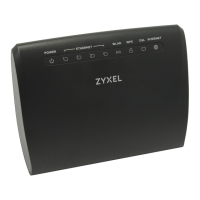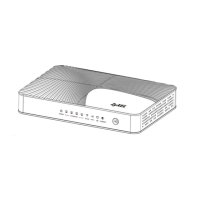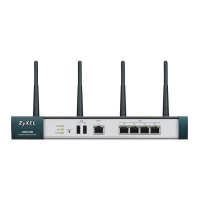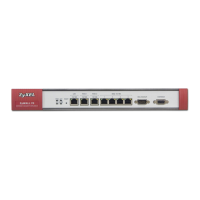Chapter 8 Wireless LAN
AMG1302-T10A User’s Guide
102
8.2.3 WPA(2)-PSK
Use this screen to configure and enable WPA(2)-PSK authentication. Click Network > Wireless
LAN to display the AP screen. Select WPA-PSK or WPA2-PSK from the Security Mode list.
Figure 49 Network > Wireless LAN > AP: WPA(2)-PSK
The following table describes the wireless LAN security labels in this screen.
Table 31 Network > Wireless LAN > AP: WPA(2)-PSK
LABEL DESCRIPTION
Security Mode Choose WPA-PSK or WPA2-PSK from the drop-down list box.
Encryption If the security mode is WPA-PSK, you can set the encryption mode to TKIP to enable
Temporal Key Integrity Protocol (TKIP) security on your wireless network.
If the security mode is WPA2-PSK, you can set the encryption mode to AES to enable
Advanced Encryption System (AES) security on your wireless network. AES provides
superior security to TKIP.
If the security mode is WPA2-PSK and WPA Compatible is selected, you can set the
encryption mode to TKIP/AES to allow both TKIP and AES types of security in your
wireless network.
WPA Compatible This check box is available only when you select WPA2-PSK in the Security Mode
field.
Select the check box to have both WPA-PSK wireless clients be able to communicate
with the Device even when the Device is using WPA2-PSK.
Pre-Shared Key The encryption mechanisms used for WPA(2) and WPA(2)-PSK are the same. The
only difference between the two is that WPA(2)-PSK uses a simple common
password, instead of user-specific credentials.
Type a pre-shared key from 8 to 63 case-sensitive ASCII characters (including spaces
and symbols).
WPA Group Key
Update Timer
The Group Key Update Timer is the rate at which the AP (if using WPA(2)-PSK key
management) or RADIUS server (if using WPA(2) key management) sends a new
group key out to all clients. The re-keying process is the WPA(2) equivalent of
automatically changing the WEP key for an AP and all stations in a WLAN on a periodic
basis.

